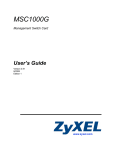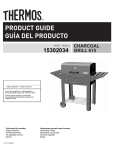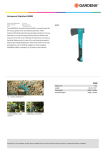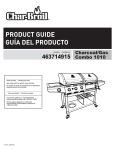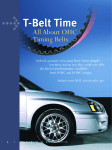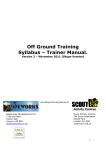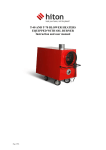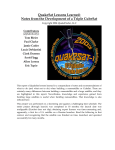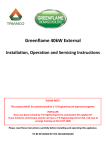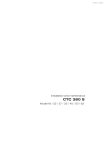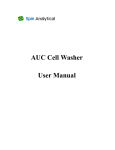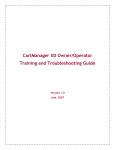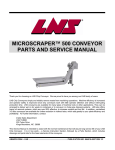Download MX-900B operations and User manual ®Total Energy Solutions LLC
Transcript
Max-Ox™ MX-900B Commercial Wood Chip-Fired Hydronic Boiler Operators Manual Max-Ox™ MX-900B Operators Manual, Rev. 0 Page 1 of 54 Max-Ox™ Model MX-900B Commercial Wood Chip-Fired Hydronic Boiler Operators Manual Please include the Manual Issue shown below when communicating with Technical Support regarding this publication. Publication History Issue Date Description of Changes Rev. 0 2/09/09 Original Max-Ox™ MX-900B Operators Manual, Rev. 0 Page 2 of 54 Max Ox™ MX-900B Operators Manual TABLE OF CONTENTS Section ___Page Manual Overview Overview of this Publication Who Should Read This Manual Supplemental Publications Codes and Insurance Notice Technical Support Warranty Registration Limited Warranty Special Symbols Specifications How it Works An Overview MX-900B Control System Fuel In-Feed Conveyor (by Customer) Fuel In-Feed System Under-fire Stoker Grate Secondary Combustion Chamber Fire-Tube Hydronic Boiler Exhaust Fan Ash Removal Wood Chips as Fuel Safety Information Installation Operation – Start-up Operation – Shut-down Touch Screen Controls Ash Cleaning Routine Lubrication Boiler Water Treatment Program Fuel Feed Jam Clearing Max-Ox™ MX-900B Operators Manual, Rev. 0 Page 3 of 54 4 4 4 5 6 7 8 13 14 16 16 17 17 18 19 19 20 20 22 23 26 28 32 33 49 51 52 52 MX-900B Operators Manual Overview of this Publication Congratulations on your decision to make very efficient use of precious renewable fuels by using a commercial-duty automated Max-Ox™ MX-900B Wood Chip-fired Hydronic Boiler. This MX-900B Operators Manual describes the features, installation, operation, and maintenance of your new Max-Ox™ MX-900B Commercial Wood-chip Fired Hydronic Boiler. Who Should Read This Manual This manual contains important information for those who will install, operate, or maintain the MX-900B Wood chip-fired Hydronic Boiler. Supplemental Publications The National Fire Protection Association (NFPA) publishes codes, standards, recommended practices, and guidelines for the installation and operation of solid fuel burning appliances. To help ensure safe installation of the Max-Ox™ MX-900B, please refer to the following NFPA publications: • NFPA 211: Standard for Chimneys, Fireplaces, Vents, and Solid Fuel Burning Appliances, 2006 Edition. For information on NFPA 211, and other related NFPA publications, please contact: National Fire Protection Association 1 Batterymarch Park Quincy, MA 02169-7471 www.nfpa.org Phone: 617-770-3000 Fax: 617-770-0700 Max-Ox™ MX-900B Operators Manual, Rev. 0 Page 4 of 54 MX-900B Operators Manual Codes and Insurance Notice The Max-Ox™ MX-900B Commercial Wood-chip Fired Hydronic Boiler is a mechanical draft, direct-vented, NON-PRESSURIZED VESSEL, solid fuel burning appliance. It must be installed in accordance with this Manual, NFPA 211, Federal, State, and Local codes, and your Insurance Underwriter’s requirements. Local building code enforcement officials and fire inspectors are given authority to determine if specific installations of solid fuel burning appliances are safe. These professionals use recommended guidelines from various nationally recognized organizations, such as the National Fire Protection Association (NFPA), and the National Electrical Manufacturer’s Association (NEMA). Please be sure to follow the requirements of the Authority Having Jurisdiction over your specific installation. Your Insurance Underwriter may also have specific guidelines with respect to installation and inspection requirements for your solid fuel burning appliance. Max-Ox™ MX-900B Operators Manual, Rev. 0 Page 5 of 54 MX-900B Operators Manual Max-Ox™ Technical Support Your Sales Representative is your authorized Max-Ox™ factory trained Technical Support team member, and is standing-by to answer any questions you may have with respect to your Max-Ox™ MX-900B Commercial Wood-chip Fired Hydronic Boiler. Please record the model number and serial number of your Max-Ox™ MX-900B in the space provided, and have this information available when contacting your factory-authorized Sales Representative: Model number: ________________ Serial Number: ________________ Operators Manual Revision Number: ________________ Purchase Date: ________________ Installation Date: ______________ Max-Ox™ MX-900B Operators Manual, Rev. 0 Page 6 of 54 Max-Ox™ Warranty Registration Form All Max-Ox™ products must be registered to activate the warranty, and we encourage you to send this registration form back to us within 10 days of installation. Please mail or fax the completed Max-Ox™ Warranty Registration Form to: Max-Ox, LLC Fax: (717) 464-0491 Mail: Max-Ox, LLC 481 Millwood Road Willow Street, PA 17584 Customer Name: _______________________________________________ Address: _____________________________________________________ _____________________________________________________ _____________________________________________________ Phone: _________________________Fax: __________________________ E-mail: _______________________________________________________ Sales Representative Name: ______________________________________ Model Number: ___________________ Serial Number: ________________ Installation Date: _______________________________________________ Customer Signature: ____________________________________________ Date: ________________________________________________________ Max-Ox™ MX-900B Operators Manual, Rev. 0 Page 7 of 54 Certificate of Limited Warranty Max-Ox™ Wood Chip-Fired Hydronic Boilers Page 1 of 5 General This Limited Warranty is only available to the original owner of this Max-Ox™ Wood-chip fired Hydronic Boiler (Unit). It is not transferable. Max-Ox, LLC (Max-Ox) warrants this Max-Ox™ Wood-chip fired Hydronic Boiler, and its component part(s), to be free from defects in materials and workmanship, under normal use and service, for the Applicable Warranty Periods. At its option, Max-Ox will repair or replace defective Max-Ox™ Wood-chip fired Hydronic Boiler, or defective component part(s), in accordance with the terms of the Limited Warranty, if it fails in normal use and service during the Applicable Warranty Periods.. Any replacement components or replacement part(s) must be Max-Ox authorized component or part(s). The replacement unit or part(s) will be warranted only for the unexpired portion of the Unit’s Applicable Warranty Periods. Effective Date: The Effective Date of the commencement of warranty coverage (or the beginning of the Applicable Warranty Periods) is the date of installation of the Unit, provided the installation, operation, and maintenance of the Unit conforms to the instructions in the Max-Ox™ MX-900B Operators Manual, applicable Federal, State, and Local codes, Customer’s Insurance Underwriter requirements, and good plumbing, electrical, and HVAC (Heating, Ventilation, Air Conditioning) trade practices. Otherwise, the Effective Date of the commencement of warranty coverage is the date of the manufacture of the Unit plus ninety (90) days. Applicable Warranty Periods Whetted hydronic heat exchanger components: Three (3) years Cast refractory on stoker doors and combustion chamber: Three (3) years Steel fabrications, mechanical components, thermal insulation: One (1) year Electrical, electro-mechanical, and electronic components: One (1) year Plumbing components (pump, valves, fittings, maifolds): One (1) year Max-Ox™ MX-900B Operators Manual, Rev. 0 Page 8 of 54 Certificate of Limited Warranty Max-Ox™ Wood Chip-Fired Hydronic Boilers Page 2 of 5 Applicable Warranty Periods (continued) During the Applicable Warranty Periods, Max-Ox will pay a pro-rated share of the cost of a defective item. For example, in the first year Max-Ox will pay 100% of the cost of any failed item; in the second year Max-Ox will pay 100% less 33.3% of the whetted hydronic heat exchanger components and cast refractory components (3 year pro-rated); and so on until the end of the Applicable Warranty Periods. Warranty Exclusions This Limited Warranty will not cover: 1. Damages to the fuel in-feed system components or fuel feed auger train components or ash auger train components or stoker head assembly components caused by non-wood materials present in the fuel that are large enough to result in jams, such as metals, rocks, masonry, fabrics, rope, stringy plant fibers. 2. Damages to the fuel in-feed system components or fuel feed auger train components or ash auger train components or stoker head assembly components caused by materials other than approved fuels. Approved Fuels are specified as follows: a. wood chips < 1.5” maximum dimension b. wood dust briquettes < 2” maximum dimension c. wood shavings d. wood construction / demolition waste < 1.5” maximum dim. 3. Whetted hydronic heat exchanger component leak failure due to contaminated or corrosive water-based heat transfer fluid or make-up water. 4. Whetted hydronic heat exchanger component leak failures due to Customer’s failure to follow a bi-annual (every 6 months) commercial boiler water chemistry program for boiler water chemical analysis, chemical treatment, boiler water blow-down, and boiler water makeMax-Ox™ MX-900B Operators Manual, Rev. 0 Page 9 of 54 up water addition for an open-system (non-pressurized) hydronic heating boiler. Certificate of Limited Warranty Max-Ox™ Wood Chip-Fired Hydronic Boilers Page 3 of 5 Warranty Exclusions (continued) 5. Service trips to your facility for instruction on how to install, operate, or maintain the Unit, or to bring the Unit into compliance with local codes or insurance underwriter requirements. 6. Units removed from the original installation location. 7. Damages, malfunctions, or failures resulting from failure to install the Unit per applicable codes, or good plumbing, electrical, or HVAC trade practices. 8. Damages, malfunctions, or failures resulting from failure to install, operate, or maintain the Unit in accordance with the Max-Ox™ MX900B Operators Manual. 9. Damages, malfunctions, or failures resulting from over-firing the Unit on combustible materials other than Approved Fuels. 10. Damages, malfunctions, or failures caused by abuse, accident, fire, flood, freezing, lightning, or acts of God. 11. Damages, malfunctions, or failures resulting from failure to operate the Unit without sufficient heat transfer fluid. 12. Cracks in the cast refractory that can be repaired with hightemperature refractory joint compound. 13. Performance problems caused by improper sizing of the Unit, improper sizing of the flue gas vent, or improper sizing of the combustion make-up air opening requirements. Labor, Shipping, and Processing Costs This Limited Warranty does not cover any labor expenses for service, repairs, reinstallation, permits, or removal and disposal of a failed Unit or its defective component part(s). All such expenses are the owner’s responsibility. Max-Ox™ MX-900B Operators Manual, Rev. 0 Page 10 of 54 Certificate of Limited Warranty Max-Ox™ Wood Chip-Fired Hydronic Boilers Page 4 of 5 Labor, Shipping, and Processing Costs (continued) Max-Ox, LLC will pay for delivery of an “in-warranty” replacement Unit or component part(s) to a location at or near the original point of delivery. The Owner is responsible for any additional local delivery, equipment rigging, and reinstallation charges. The owner is also responsible for freight costs incurred in the return of a defective Unit or component part(s) to the point of purchase. Activation of Warranty All Max-Ox™ products must be registered to activate the warranty, and we encourage you to send this registration form back to us within 10 days of installation. The Warranty Registration Form is located on page 7 of this manual. Please mail or fax the completed Max-Ox™ Warranty Registration Form to: Max-Ox, LLC; fax: (717) 464-0491 Mail: Max-Ox, LLC 481 Millwood Road Willow Street, PA 17584 How to Obtain Warranty Claim Assistance Max-Ox™ MX-900B Operators Manual, Rev. 0 Page 11 of 54 Warranty Claims must be made promptly to your factory authorized Sales Representative. Your Sales Representative will assist you through the claim process with costs apportioned as described elsewhere in this Limited Warranty. Certificate of Limited Warranty Max-Ox™ Wood Chip-Fired Hydronic Boilers Page 5 of 5 How to Obtain Warranty Claim Assistance (continued) Max-Ox, LLC reserves the right to inspect, or require the return of, a failed Unit for defective part(s). If requested items are not returned, or are returned without all of the component parts intact, Max-Ox, LLC reserves the right to invoice the Owner for the replacement Unit or part(s). Exclusive Warranty – Limitation of Liability This Limited Warranty is the only Warranty for this Unit given by Max-Ox, LLC. No one is authorized to make any other warranties for the Unit or its component part(s) on behalf of Max-Ox, LLC. ANY IMPLIED WARRANTIES, INCLUDING MERCHANTABILITY, FOR FITNESS FOR A PARTICULAR PURPOSE, SHALL NOT EXTEND BEYOND THE APPLICABLE WARRANTY PERIODS. THE SOLE LIABILITY OF MAX-OX, LLC, WITH RESPECT TO ANY DEFECT, SHALL BE AS SET FORTH IN THIS LIMITED WARANTY, AND ANY CLAIMS FOR INCIDENTAL OR CONSEQUENTIAL DAMAGES (INCLUDING DAMAGE FROM WATER LEAKAGE) ARE EXCLUDED. Some states do not allow limitations on how long an implied warranty lasts, or for the exclusion of incidental or consequential damages, so the above limitations or exclusions may not apply to you. This Limited Warranty gives you specific legal rights, which vary from state to state. Max-Ox™ MX-900B Operators Manual, Rev. 0 Page 12 of 54 MX-900B Operators Manual Special Symbols Note the use of signal words: DANGER, WARNING, and CAUTION with safety messages. The appropriate Signal Word has been selected using the following guidelines: DANGER: Indicates an imminently hazardous situation which, if not avoided, will result in death or serious injury. WARNING: Indicates a potentially hazardous situation which, if not avoided, will result in death or serious injury. CAUTION: Indicates a potentially hazardous situation which, if not avoided, may result in minor or moderate injury, or serves as a reminder to follow appropriate safety practices. Max-Ox™ MX-900B Operators Manual, Rev. 0 Page 13 of 54 Max-Ox™ MX-900B Operators Manual, Rev. 0 Page 14 of 54 MX-900B Operators Manual Specifications Your new Max-Ox™ MX-900B is classified as a fully modulated (automatic), induced draft, under-grate stoker fed wood chip-fired hydronic heating (hot water) boiler. a. Nominal Output, BTU/hr: 900,000 b. Design Supply Temperature: 180°F c. Approved Fuels: o wood chips < 1.5” maximum dimension o wood dust briquettes < 2” maximum dimension o wood shavings o wood construction / demolition waste < 1.5” maximum dimension d. Heat exchanger type: 2-pass fire tube type (non-condensing) e. Material: Carbon Steel per ASTM A-36 f. Heat transfer fluid: water g. Working pressure: 0 psig (atmospheric, NON-PRESSURIZED) h. Design Supply temperature: 180 °F i. Modulated (variable) speed primary loop circulator j. Heat Transfer Fluid Capacity: 300 gallons k. Fluid Temperature Control: PLC l. Supply & Return connections: 3 inch female NPT m. Draft type: Induced draft n. Flue gas stack outlet diameter: 8 inches o. Ash Clean-out: full-access top removable panels, (3) exhaust plenum doors, ash cyclone container, ash auger bin, front and rear stoker head access doors, bolted stoker grate access panel p. Thermal insulation envelope: full coverage mineral wool blanket on heat exchanger and combustion section, cast refractory on stoker head doors and secondary combustion section.. q. Enclosure: non-weather-tight primed and painted steel r. Dimensions: 6 ft. wide x 14 ft long ( includes metering bin and fuel auger) x 10 ft-6 inch to top of boiler s. Weather enclosure ceiling height for boiler top panel removal: 14 feet Max-Ox™ MX-900B Operators Manual, Rev. 0 Page 15 of 54 MX-900B Operators Manual Specifications (cont) t. Electrical Requirements: 30 Amp, 240 VAC, 1 phase, 3-wire plus safety ground u. Operating current: 8 Amps v. Auxiliary control dry contacts 1. Boiler Ready signal contact 2. System Alarm signal contact 3. Fuel In-Feed conveyor control contact 4. Heat Dump control contact w. Combustion turn-down ratio: 8:1 x. Fuel Auger Tube Fire Extinguisher Water connection: _ female NPT, 1/2 inch minimum supply pipe diameter @ 40 psi minimum water pressure y. Dry (shipping & rigging) weight: 7,800 lbs Max-Ox™ MX-900B Operators Manual, Rev. 0 Page 16 of 54 MX-900B Operators Manual How it Works An Overview Your new MX-900B Wood chip-fired Hydronic Boiler (hot water heating boiler) is a very modern version of a very old and time-proven method for properly burning solid fuels; called the “under-fire stoker grate” method. What sets your MX-900B system apart from previous older generations of under-fire stoker grate systems is that the MX-900B system makes use of modern advances in controls technology and knowledge of combustion chemistry, along with advances in materials science and modern manufacturing methods, to provide you with a rugged, highly fuel efficient and low maintenance automatic wood chip-fired combustion system. This How it Works narrative is written to guide you through each functional sub-assembly of the MX-900B Combustion System, so that you will gain a clear understanding of the entire unit. MX- 900B Control System: The automatic control system of the MX-900B system is a modern version of proven combustion control strategy. The MX-900B Control System hardware consists of an industrial-duty programmable logic controller (microprocessor-based PLC), touch-screen Operator interface control / view panel, three variable speed AC motor controllers, and a very carefully selected array of robust automation sensors. These industrial-duty controls components are orchestrated in unison through a carefully designed, and extensively field tested, set of software programs that are permanently stored in the memory of the programmable logic controller. The control system is designed to ensure safe operating conditions are maintained at all times, and to initiate an automatic shut-down in the event of a fault. Max-Ox™ MX-900B Operators Manual, Rev. 0 Page 17 of 54 Fuel In-Feed System Conveyor ( by Customer): You will need to provide wood chip fuel in-feed conveyor system in order to supply fuel to your MX-900B unit. Your fuel in-feed system should be tailored to your specific site layout requirements. We recommend that your fuel storage bin or silo be designed to protect your wood chips from the weather. Your wood chip transfer conveyor should be designed to transport fuel from your storage bin/silo to the MX-900B Fuel Metering Bin. 1. Sizing your Transfer Conveyor: Your transfer conveyor system should be sized to convey approximately _ to 1 cubic yards of wood chips per hour in order to support the maximum fuel firing rate of the Max-Ox unit. This fuel flow rate criteria is a conservative estimate that takes into account the additional fuel volume flow needed when firing green (fresh-cut) hardwood wood chips, as well as the variations in bulk density (fluffiness) of the chipped or shredded wood fuel types available. Of course, the dryer your fuel is, the less of it you will need to burn to achieve the full power rating of renewable fuel combustion units. Fuel In-Feed System: Your MX-900B mechanical hardware begins at the fuel in-feed system. The fuel in-feed system serves to automatically receive wood chips from your fuel storage and transfer system, and then deliver them to the stoker grate combustion unit. The fuel in-feed system consists of an inlet chute, an air operated knife gate, a small auxiliary electric air compressor, a small storage chamber called the metering bin, a fuel in-feed auger with variable speed drive motor, and a set of automatically controlled electrical contacts to energize your fuel infeed conveyor motor controller. Inlet Chute, Knife Gate, Metering Bin, and Air Compressor: The fuel in-feed system inlet chute serves to funnel wood chips through an open knife gate, and into the metering bin. A level sensor in the metering bin signals your fuel transfer conveyor to stop, and Max-Ox™ MX-900B Operators Manual, Rev. 0 Page 18 of 54 closes the knife gate. The auxiliary air compressor provides compressed air for actuation of the knife gate. Fuel Feed Auger and Drive Motor: Wood chip fuel is fed by a rotating helical auger from the metering bin and on into the stoker grate combustion unit. The fuel feed auger is located in the bottom of the metering bin, and extends into the stoker grate combustion unit. The variable speed electric motor and gear reduction assembly that drives the auger is equipped with an automatic jam clearing feature to protect your system in the event your fuel inadvertently becomes contaminated with unwanted metals or stones that cause the auger to jam. Fuel Feed Tube Fire Extinguisher: The fuel feed tube between the metering bin and the stoker is equipped with a thermostatically actuated water valve and thermostatic sensing element. Should the temperature of the fuel within the fuel feed tube increase to 150 °F, water will begin to spray into the fuel feed tube to extinguish any fire that may be present. Below 150°F the fire extinguisher valve is fully closed, and at a set-point of 190°F the valve is fully open. Under-fire Stoker Grate: An under-fire stoker grate combustion system is a simple time-proven and robust method for conveying solid fuels into a combustion chamber. Wood chips are conveyed by a rotating helical fuel in-feed auger from the fuel in-feed metering bin and on into the stoker unit. Fuel gently spills out of the mouth of the stoker cavity, and onto a stationary ring-shaped grate. Very thin slots in the ring grate permit preheated fresh combustion air to permeate the fuel bed that has spilled onto the top of the ring grate, and thereby sustain a steady fire on the exposed surface of the fuel. Combustion Air Adjustment: Three manually adjustable combustion air slide gates are mounted on the exterior face of the stoker grate assembly. One slide gate serves to manually adjust and set the Primary combustion air flow rate up through the thin slots in the stoker ring grate. A second slide gate serves to manually adjust and set the Secondary combustion air flow rate into the Secondary Combustion Chamber lower combustion air inlets. A third slide gate Max-Ox™ MX-900B Operators Manual, Rev. 0 Page 19 of 54 serves to manually adjust and set the Tertiary combustion air flow rate into the Secondary Combustion Chamber upper combustion air inlets. Secondary Combustion Chamber: All of the hot gases rising off of the burning surface of the fuel rise upward into a well-insulated but extremely hot ceramic-lined secondary combustion chamber. Carefully proportioned and highly preheated secondary combustion air is introduced into the rising flammable fuel gases within the secondary combustion chamber in such a way as to promote thorough mixing with the rising fuel gasses. The resultant mixture produces very high combustion temperatures, and therefore very complete combustion. Fire-Tube Hydronic Boiler: All of the very high temperature fully combusted gasses continue to flow upward into a modern, high efficiency, 2-pass hydronic heat exchanger, wherein all of the available heat energy is extracted, without permitting water vapor in the flue gas to condense. Heat energy is transferred to circulating water for your hydronic space heating or industrial /commercial process hot water needs. Heat Exchangers and Water Vapor: The Hot Water Heating Boiler system flue gas exhaust temperature and the boiler return temperature are automatically controlled so as to prevent condensation of water vapor within the heat exchanger. This means that just enough heat energy deliberately remains in the exhaust gases so that the water vapor does not cool down to the point where liquid water forms within the heat exchangers, or your chimney. Instead, the water remains in the vapor state, and is exhausted into the atmosphere. On cool days you will see this water vapor form a vapor cloud plume as the exhaust rises up into the atmosphere. Max-Ox™ MX-900B Operators Manual, Rev. 0 Page 20 of 54 Exhaust Fan (Induced Draft): A variable speed exhaust fan, referred to as an “Induced Draft” fan, is mounted on the exhaust connection of your heat exchanger. This variable-speed electric fan serves to pull fresh combustion air through both the primary and secondary combustion air pre-heater sections, and into the combustion chambers, pulls all combustion gases through the combustion chambers and heat exchanger, pulls particulate laden flue gas through a high efficiency cyclone dust collector, and then pushes the combustion exhaust gasses (including water vapor) up the chimney and out into the atmosphere. Ash Removal: As a solid fuel, wood is perhaps the best renewable fuel on the planet from a “minimum ash content” perspective because wood has less than 1% ash content by weight (example: Oak = 0.15% ash by weight). For the sake of comparison, coal mined in the United States ranges from 5% to 20% ash by weight. When compared to coal ash, wood ash is much more soft, fine, and fragile, and as such becomes airborne more easily. Your MX-900B ash removal system has been designed to address wood ash removal as follows: Rotating Ash Ring, Ash Plow, Ash Auger & Ash Bin: The burning surface of the fuel bed situated on top of the ring grate converts the resinous lignin (sap) and solid fixed-carbon in the wood into flammable gases, leaving behind non-combustible minerals as “ash”. As fresh fuel is pushed out of the center of the stoker mouth and onto the ring grate, the ash which has formed around the perimeter of the burning pile is pushed further out-board away from the ring grate, and onto a slowly rotating solid ring, called the “ash ring”. Ash Plow: a fixed-position diagonal plow blade located above the rotating ash ring scrapes ash material into an ash trough as the ash ring rotates beneath the plough. Ash Auger: A variable speed, motor-driven ash auger, situated in a trough located out-board and slightly below the rotating ash ring, receives ash scraped off of the ash ring by the plough. The Max-Ox™ MX-900B Operators Manual, Rev. 0 Page 21 of 54 ash auger rotates slowly to transport ash out of the combustor stoker assembly, and into a covered ash bin. Both the rotating ash ring and the ash auger are driven by the same variablespeed electric motor and reduction gear assembly. Ash Bin: A covered ash bin, located out-side of and adjacent to the stoker assembly, serves to receive the ash from the ash auger. The ash bin cover is removable, and the ash bin is detachable and removable from the ash auger assembly. The ash bin is manually emptied when 75% full of ash. Hydronic Boiler Ash Clean-out Doors: The hydronic boiler is equipped with three lower exhaust plenum ash clean-out doors, and four upper ash clean-out panels to access boiler tubes. The lower ash clean-out doors are insulated, hinged, and latched assemblies that permit removal of fly ash that has accumulated in the boiler exhaust gas plenum. Four insulated and clamped removable upper ash clean-out / boiler tube access panels are situated on top of the boiler. The four upper panels permit removal of fly ash that has accumulated in the upper boiler exhaust gas reversal plenum, as well as provide access to the heat exchanger tubes and removable fire-tube turbulators for cleaning during routine maintenance. Stoker Clean-out Doors: The stoker unit is equipped with two hinged, latched and insulated clean-out doors that permit removal of fly ash that has accumulated in the stoker unit. Ash removal from this region is performed infrequently during routine maintenance. Removable Stoker Grate: The slotted ring-shaped stoker grate is built as four removable circular segments, so that any fine mineral or sand particles present in the fuel that have fallen into the primary combustion air chamber beneath the stoker grate can be cleaned out during routine maintenance. Stoker Grate Access Panel: The stoker grate assembly is fitted with a bolted and removable ash clean-out access panel, which is removed for ash clean-out access during routine maintenance. Particulate Cyclone: Coupled to the boiler is a high efficiency particulate cyclone dust collector designed to remove fly ash from the Max-Ox™ MX-900B Operators Manual, Rev. 0 Page 22 of 54 flue gas prior to discharge of the gas up the exhaust stack. The conical section of the cyclone is equipped with an isolation damper and a sealed ash collection container. The container is removed and emptied during routine maintenance. Wood Chips as a Fuel: Your MX-900B Combustion System has been designed for, and is approved for, the efficient combustion of dry wood chips, green (freshcut) wood chips, hogged (shredded) dry wood, hogged (shredded) green (fresh-cut) wood, and shredded wood construction demolition waste (tramp metal removed), for all species of wood. Fuel Contaminants – Metals & Stones: The fuel in-feed auger and the ash auger are stout and robust in design and construction. Also, the fuel in-feed auger is equipped with an automatic jam-clearing feature. However, there is a practical limit as to how much tramp metal or stone a mechanical auger will tolerate. Therefore, we advise that you take care to ensure that your fuel supply is as free of these contaminants as possible. Wet Fuel Economics: We recommend that you avoid un-necessary water in your wood-chip fuel. As a general rule, the amount of recoverable (available-for-use) heat energy from green (fresh-cut) or hardwood chip fuel is less than half of what could have been recovered had the wood chips been allowed to air dry naturally, and then protected from the weather. Wet Fuel = Increased Fuel Use: Your MX-900B system will properly burn green (fresh-cut) wood chips very well, and has been intentionally designed and tested for this type of fuel. Unfortunately, as is the case for any type of combustion system, be it fossil fuel-fired or a biomass fuel-fired, the high amount of heat stored in the exhaust gas water vapor is significant. When possible, we advise that you avoid any unnecessary additional water in your fuel because of the increased fuel consumption needed to evaporate the water. Max-Ox™ MX-900B Operators Manual, Rev. 0 Page 23 of 54 Safety Information Safety Precautions Use only those fuels listed in the Introduction and Specifications section. Use of un-approved fuels may void your warranty. Please see the warranty section of this manual for specific limitations with respect to approved fuel types. For approval to use fuels other than those listed in this manual, please contact your Authorized Max-Ox Sales Representative. Use of fuels other than those approved in this manual, or in writing by the Max-Ox Company, may create a fire hazard or safety hazard, and may void your warranty. Do not use gasoline, naptha,, lighter fluid, fuel oil, engine oil, or other any other flammable liquid or petroleum product in, on, or near MX-900B Units.. Operate Max-Ox™ MX-900B Units at atmospheric pressure only. Keep the vent cap loose on the vent opening. Do not seal or clamp down on the vent cap. Keep the area around MX-900B Boilers clear of combustible materials to avoid a fire hazard. Ashes must be contained in a non-combustible container with a tight-fitting lid. Observe the Required Clearances to Combustible Surfaces as specified in National Fire Protection Association 211, Standard for Chimneys, Fireplaces, Vents, and Solid Fuel-Burning Appliances, for installation of MX-900B, as well as for installation of fuel storage containers, bins, silos, and fuel transfer conveyor equipment, and for installation of, or connection to chimney connectors and/or chimney systems. Max-Ox™ MX-900B Operators Manual, Rev. 0 Page 24 of 54 When inspecting the stoker-grate combustion chamber, open the door slowly. Be sure to review all safety information in this manual prior to operating the unit. Please contact your Authorize Sales Representative if you have questions that are not covered in this manual. Safety Alert Symbol The Safety Alert symbol identifies important safety messages in the manual. This symbol indicates the possibility of injury or death. Follow all instructions in the safety message given. This symbol means “attention”, “be alert”, and “your safety is involved”. Maintenance Safety Electrocution Hazard. Disconnect and lock-out / tag-out the electrical power supply to the Max-Ox™ 900B, prior to performing any service or maintenance. Do Not Operate the MX- 900B without all safety guards in place, and all doors closed and latched.. Max-Ox™ MX-900B Operators Manual, Rev. 0 Page 25 of 54 Fire Hazard. Ash and/or residue may ignite outside of the combustion chamber. In the event of a fire: • Press Emergency Stop Button • Use Fire Extinguisher to contain fire • Contact your local Fire Department Fire Hazard. Collect ashes in a non-combustible container with a tight-fitting lid. Do not place waste other than ashes in same container. Surfaces may be Hot! Please wear full coverage protective clothing , shoes, leather gloves, and safety glasses when performing routine maintenance on your MX-900B. Max-Ox™ MX-900B Operators Manual, Rev. 0 Page 26 of 54 Installation The Max-Ox™ MX-900B Commercial Wood-chip Fired Hydronic Boiler is a mechanical draft, direct-vented, NON-PRESSURIZED VESSEL, solid fuel burning appliance. It must be installed in accordance with this Manual, NFPA 211, Federal, State, and Local codes, and your Insurance Underwriter’s requirements. Local building code enforcement officials and fire inspectors are given authority to determine if specific installations of solid fuel burning appliances are safe. These professionals use recommended guidelines from various nationally recognized organizations, such as the National Fire Protection Association (NFPA), and the National Electrical Manufacturer’s Association (NEMA). Please be sure to follow the requirements of the Authority Having Jurisdiction over your specific installation. Your Insurance Underwriter may also have specific guidelines with respect to installation and inspection requirements for your solid fuel burning appliance. The Max-Ox™ MX-900B must be installed per the requirements of National Fire Protection Association (NFPA) 211: Standard for Chimneys, Fireplaces, Vents, and Solid Fuel Burning Appliances, 2006 Edition. Minimum horizontal clearance from combustible materials must be 48 inches in order to permit access door operations during routine maintenance. Where permissible, additional horizontal clearance is desirable for ease of maintenance access. Minimum clearance from the top of the hot water heating boiler to a combustible ceiling shall be no less than 36 inches. Additional vertical clearance is desirable, where possible, for ease of maintenance access. The MX-900B must be placed on a non-combustible concrete surface designed to support the 7,800 pound shipping weight of the unit, plus an additional 2,500 pounds for the heat transfer fluid in the hot water heating boiler. Max-Ox™ MX-900B Operators Manual, Rev. 0 Page 27 of 54 The MX-900B must be shimmed level and plumb during installation. All aspects of installation shall conform to good plumbing, electrical, or HVAC trade practices. Proper pump(s) and piping sizing is the responsibility of your qualified installer. The Max-Ox™ MX-900B is an open system NON-PRESSURIZED hydronic Boiler. DO NOT PRESSURIZE. An open (vented) expansion tank must be incorporated into the system in order to maintain the heat exchanger (boiler) full of water at all times, and to prevent pressurization. No valve or restriction is permissible in the pipe connecting the heat exchanger to the expansion tank. Please allow for a minimum of 20 gallons of water volume thermal expansion for the heat exchanger water thermal expansion. Additional vented expansion tank thermal expansion allowance will be required to accommodate your hydronic system thermal expansion. When interfacing with an existing pressurized heating system, a heat exchanger is required. Once installed and filled, add boiler water treatment immediately. In order to minimize corrosion of your carbon steel heat exchanger whetted surfaces, you must follow a bi-annual (every 6 months) commercial boiler water chemistry program for boiler water chemical analysis, chemical treatment, boiler water blow-down, and boiler water make-up water addition for an open-system (non-pressurized) hydronic heating boiler. Failure to follow a bi-annual commercial boiler water treatment program will void the Limited Warranty: Please fix any piping system leaks as soon as possible. Frequent additions of fresh make-up water introduces corrosive oxygen into the system. Max-Ox™ MX-900B Operators Manual, Rev. 0 Page 28 of 54 Operation MX-900B Start-up 1. Manually switch “On” Main electrical disconnect switch 2. Verify Emergency Stop palm button is reset (pulled up) 3. On Overview Screen, press the “On/Off” rotary switch icon to display the Combustion System screen. 4. Press the “Enable” icon on Combustion System screen Note: if the fuel Metering bin is not full, the Fuel InFeed timer will count down to zero, and then automatically begin to fill the Metering Bin. 5. Return to the Overview screen. 6. Press the Gages icon 7. Press the Stack O2 % Bar Graph icon to display the O2 Control screen. 8. Press the Control Mode “Auto” icon 9. Return to the Overview screen 10. Press the ID Fan icon to display the ID Fan screen 11. Press the “Auto” icon 12. Press the “Start” icon. The ID fan motor will start. 13. Return to Overview Screen 14. Press the Feed Auger icon to go to Feed Auger screen 15. Press the “Auto” icon to enable automatic feed auger control 16. Press the “Start” icon to start the feed auger motor. Max-Ox™ MX-900B Operators Manual, Rev. 0 Page 29 of 54 Note: The Feed Auger will commence transfer of fuel into to the stoker. The elapsed time required to fill the fuel Feed Auger tube is approximately 3 to 5 minutes. Fuels with high density will take longer to fill the auger tube than will fuels of low density. 17. Open the front access door to the stoker unit (door with viewing window) 18. Continue to monitor Feed Auger performance. Permit the Feed Auger to push fuel up onto the stoker grate until a pile approximately 8 to 10 inches in diameter forms. 19. Immediately shut off the Feed Auger by pressing the “Stop” icon. 20. Fully close the Secondary and Tertiary air gates. 21. Fully open the Primary air gate 22. Ignite the top of the fuel pile with a hand-held Propane or Mapp™ gas torch in three locations across the surface of the fuel pile. 23. Close and latch the stoker unit front access door 24. Observe the fuel pile through the front door viewing window until fuel pile is well ignited. 25. Press the Feed Auger “SP” (set-point) icon 26. On the Keypad screen, enter a value of 50 (percent) 27. Press the Feed Auger Speed Control “Manual” icon Max-Ox™ MX-900B Operators Manual, Rev. 0 Page 30 of 54 28. Press the Feed Auger Motor Control “Start” icon to start the feed auger. Note: The feed auger motor will start, and remain running at 50% speed until the flue gas temperature rises to 200 °F, at which point the Combustion Control system engages automatic control of the feed auger. While in the “Manual” mode, the 50% speed set-point serves to prevent over-feeding of fuel into the stoker for fuels that are difficult to ignite. 29. Return to the Overview screen 30. Press the Gage icon to go to the Gages screen 31. Press the “Supply” bar graph to go to Supply Temperature Controller screen . 32. Verify that the boiler supply set-point does not exceed 180°F Note: to change boiler set-point, press the “Set-point” icon, and then key in the desired new set-point. 33. Return to the Overview screen 34. On the Overview screen, observe the Stack Temperature indication. Note: The stack temperature will continue to rise. When the stack temperature reaches 200 °F, the Combustion Control system will engage the automatic mode. Upon automatic engagement of the control system, the Indicator Light (on the top of the electrical panel enclosure) changes to green, the Boiler Pump motor starts automatically, the Ash Auger motor starts automatically, and both the ID Fan motor and the Feed Auger motor remain in automatic operation. 35. Manually adjust the secondary air gate to approximately _ open of full gate travel. Note: this is an initial setting for the Secondary air gate, and will be final adjusted after the combustion chamber warms up. Max-Ox™ MX-900B Operators Manual, Rev. 0 Page 31 of 54 36. Manually adjust the Tertiary air gate to approximately 1/8 open of full gate travel. Note: this is an initial setting for the Tertiary air gate, and will be final adjusted after the combustion chamber warms up. 37. Once the boiler return water temperature reaches 140 °F, the combustion chambers are warmed up enough for final air adjustment. 38. Perform final adjustment of the Primary air gate as follows: • Wide open for wet fuel. Lock gate position with thumb screw. • No less than 50% open for dry fuel (ensures sufficient primary air for stoker grate cooling). Lock gate position with thumb screw. 39. Perform final adjustment of the Secondary air gate as follows: While observing the flame profile above the primary grate (lower viewing window), slowly change the position of the Secondary air grate as necessary until the flame entering the mouth of the secondary combustion chamber (immediately above the fuel pile) just begins a tendency to be pushed down under the refractory ledge located at the mouth perimeter of the secondary combustion chamber. Lock gate position with thumb screw. 40. Perform final adjustment of the Tertiary air gate as follows: While observing the flame profile adjust Tertiary air gate as necessary to allow the flame in the secondary combustion chamber (as viewed through the upper viewing window) to rise up beyond the viewing window. Lock gate with thumb screw. 41. Start-up is now complete and combustion control is in automatic mode. 42. Confirm Start-up is now complete and Automatic Combustion Control is engaged as follows: On Overview screen, confirm: • Rotary Selector Switch icon screen indicates “On” (green) • ID Fan icon indicates “On” (green) • Circulator pump indicates “On” (green) Max-Ox™ MX-900B Operators Manual, Rev. 0 Page 32 of 54 • • • • Feed Auger indicates “On” (green) Ash Auger indicates “On” (green) Flame symbol indication is present under the boiler icon Control panel Indicator light is green Continue to monitor the heat-up of the boiler. Observe that as the boiler supply water temperature boiler rises to within 5 °F to 6 °F of the boiler supply set-point, the ID Fan, Feed Auger, and Ash Auger will begin to ramp down in order to establish constant steady-state (modulated) temperature control of the boiler supply temperature without overshoot. MX-900B Shut-down 1. Return to Overview screen. 2. Press the Rotary Selector Switch icon to open the Combustion Controls screen. 3. Press the “Disable” icon to dis-engage the automatic combustion controls. The system will commence a controlled automatic shutdown. Note: The Indicator Light will begin to flash yellow, which indicates that a controlled system shut-down has commenced. Note: The Feed Auger will continue to operate until the Metering Bin fuel is emptied in order to prevent a shut-down state burn-back of fuel into the fuel Metering Bin. Note: When shutting down the MX-900B, the boiler and load circulating pumps must be operated until the fuel in the combustion chamber is consumed. As long as there is burning fuel in the combustion chamber, the water in the boiler will continue to absorb heat. Max-Ox™ MX-900B Operators Manual, Rev. 0 Page 33 of 54 Touch Screen Controls Overview Screen On / Off Rotary Switch • Press Switch icon to open Combustion System control screen. • Displays Combustion System status: On (green), Off (red) ID Fan • Press ID Fan icon screen icon to open ID Fan control screen. • Displays ID Fan motor run status: run (green), stop (red) • % display, located to left of ID Fan icon, displays variable speed ID Fan motor speed as a percentage of the full range bounded by the minimum and maximum motor frequency set-points. Flue Gas Temperature • Located above the ID Fan icon • Displays flue gas temperature, °F O2 % • Located to right of ID fan icon. • Displays (%) oxygen concentration in flue gas Max-Ox™ MX-900B Operators Manual, Rev. 0 Page 34 of 54 Feed Auger Motor • Press Motor icon to open Feed Auger control screen • Displays Feed Auger motor status: run (green), stop (red) • % display, located above Feed Auger motor icon, displays variable speed Feed Auger motor speed as a percentage of the available speed range bounded by the minimum and maximum motor frequency setpoints. Fuel In-Feed • Press In-Feed icon to open Fuel InFeed control screen • Displays time remaining until an automatic Metering Bin fill cycle will occur. Ash Auger Motor • Press Motor icon to open Ash Auger control screen • Displays Ash Auger motor status: run (green), stop (red) • % display, located to right of Ash Auger motor icon, displays variable speed Ash Auger motor speed as a percentage of the available speed range bounded by the minimum and maximum motor frequency setpoints. Alarms • Press Alarm icon to open the Alarms control screen Gage • Press Gage icon to open the Gages screen Boiler Pump • Press Boiler Pump icon to open the Boiler Pump control screen. • Displays Boiler Pump motor status: run (green), stop (red) Load Btu/hr • Displays the instantaneous power output of the boiler vessel, BTU/hr Boiler Vessel • Press Boiler Vessel icon to open Supply Temp. Controller screen. Max-Ox™ MX-900B Operators Manual, Rev. 0 Page 35 of 54 Flame • Flame image is displayed when the flue gas exhaust stack temperature is at or above 200F, and also signifies that the Combustion Control system has engaged the Automatic Control mode. Combustion System Screen Enable • Press Enable icon to permit engagement of the automatic Combustion Control when the flue gas exhaust stack temperature is at or above 200F. Disable • Press Disable icon to shut off the Fuel InFeed system and commence automatic shutdown of the Combustion System. Overview • Press Overview icon to open the Overview screen Max-Ox™ MX-900B Operators Manual, Rev. 0 Page 36 of 54 Alarms • Press Alarms icon to open the Alarms screen ID Fan Screen Speed Control Auto • Press Auto icon to enable ID Fan in automatic control when the flue gas exhaust stack temperature is at or above 200F Speed Control Manual • Press Manual icon to engage ID Fan in manual control mode. Manual mode is only available below 170F °F stack temperature (decreasing) Speed Control SP (Set-Point) • Press SP icon to change ID Fan speed set-point • Displays the current ID Fan speed set-point as a percentage of the available speed range bounded by the minimum and maximum motor frequency set-points Motor Control Start • Press Start icon to manually start ID Fan Max-Ox™ MX-900B Operators Manual, Rev. 0 Page 37 of 54 Motor Control Stop • Press Stop icon to manually stop ID Fan Motor Control CV • Displays ID Fan variable speed drive Control Value Minimum Speed • Press Minimum icon to change the ID Fan minimum speed set-point Maximum Speed • Press Maximum icon to change ID Fan maximum speed set-point Overview • Press Overview icon to open the Overview screen Max-Ox™ MX-900B Operators Manual, Rev. 0 Page 38 of 54 Gages Screen Stack Temperature • Displays flue gas exhaust stack temperature, °F Stack O2 % • Displays (%) oxygen concentration in flue gas • Press Stack O2 bar scale icon to open the Stack O2 control screen. Supply Temperature • Displays boiler supply (outlet) water temperature, °F • Press Supply Temperaature scale icon to open the Supply Temperature Controller screen. Return Temperature • Displays the boiler return (inlet) water temperature, °F Max-Ox™ MX-900B Operators Manual, Rev. 0 Page 39 of 54 Stack O2 Screen Oxygen Trim SP (Set-Point) • Press SP icon to change the % Oxygen set-point. Oxygen Trim PV • Displays actual O2% concentration Oxygen Trim CV • Factory-use-only control system parameter. Control Mode Auto • Press Auto icon to engage automatic O2% control Control Mode Manual • Press manual icon to disengage automatic O2 % control O2 Idle Mode • Press O2 Idle Mode icon to display O2 Idle Mode screen Overview • Press Overview icon to return to Overview screen Max-Ox™ MX-900B Operators Manual, Rev. 0 Page 40 of 54 O2 Idle Mode Screen Start • Press Start icon to engage combustion system O2 idle mode Stop • Press Stop icon to disengage combustion system O2 idle mode Idle Differential Mode • Press Idle Differential mode icon to change the Idle Mode Differential Return • Press Return icon to return to Stack O2 screen Overview • Press Overview icon to return to Overview screen Max-Ox™ MX-900B Operators Manual, Rev. 0 Page 41 of 54 Supply Temperature Controller Screen Set-point • Displays boiler supply (outlet) water temperature control set-point, °F • Press Set-point icon to change boiler supply water temperature control set-point Process Value • Displays the actual boiler supply (outlet) water temperature, °F Control Value • Displays the instantaneous Combustion System power output as a percentage of full power. Overview • Press Overview icon to open the Overview screen Max-Ox™ MX-900B Operators Manual, Rev. 0 Page 42 of 54 Fuel In-Feed Screen Manual Air Gate Open • Press Open icon to toggle open fuel Metering Bin Air Gate. Release of the touch screen icon will close the Air Gate. Bin Fill Time Delay Pre-set • Displays the set-point time delay between Metering Bin refill cycles, minutes • Press PRE icon change Metering Bin Fill Time Delay set-point. Bin Fill Time Delay Current Status • Displays time remaining until Metering Bin refill cycle begins Max-Ox™ MX-900B Operators Manual, Rev. 0 Page 43 of 54 Feed Auger Screen Speed Control Auto • Press Auto icon to enable engage automatic speed control of Feed Auger motor Speed Control Manual • Press Manual icon to disengage automatic speed control of Feed Auger motor Motor Control Start • Press Start icon to start the Feed Auger motor Motor Control Stop • Press Stop icon to stop the Feed Auger motor Motor Control Forward • Press Forward icon to select continuous forward rotation of the Feed Auger motor. Max-Ox™ MX-900B Operators Manual, Rev. 0 Page 44 of 54 Motor Control Reverse • Press Reverse icon to jog the Feed Auger motor in the reverse rotation direction. Speed Control SP (Set-point) • Displays Feed Auger motor speed set-point as a percentage of the available speed range bounded by the minimum and maximum motor frequency set-points. Motor Control CV • Displays Feed Auger Motor speed instantaneous control value as a percentage of the available speed range bounded by the minimum and maximum motor frequency set-points Minimum Speed • Press Minimum icon to change Feed Auger minimum speed set-point Maximum Speed • Press Maximum icon to change Feed Auger maximum speed set-point Overview • Press Overview icon to open the Overview screen Max-Ox™ MX-900B Operators Manual, Rev. 0 Page 45 of 54 Ash Auger Screen Speed Control Auto • Press Auto icon to enable engage automatic speed control of Ash Auger motor Speed Control Manual • Press Manual icon to disengage automatic speed control of Ash Auger motor Motor Control Start • Press Start icon to start the Ash Auger motor Motor Control Stop • Press Stop icon to stop the Ash Auger motor Max-Ox™ MX-900B Operators Manual, Rev. 0 Page 46 of 54 Speed Control SP (Set-point) • Displays Ash Auger motor speed set-point as a percentage of the available speed range bounded by the minimum and maximum motor frequency set-points. Motor Control • Displays Ash Auger Motor speed instantaneous control value as a percentage of the available speed range bounded by the minimum and maximum motor frequency set-points Minimum Speed • Press Minimum icon to change Ash Auger minimum speed set-point Maximum Speed • Press Maximum icon to change Ash Auger maximum speed set-point Overview • Press Overview icon to open the Overview screen Max-Ox™ MX-900B Operators Manual, Rev. 0 Page 47 of 54 Alarm Screen Alarms: • Out of Fuel : Initiates on low stack temperature during automatic combustion control • ID Fan Air Flow: Initiates upon loss of Proof of Draft Switch signal • ID Fan VFD: Initiates upon ID Fan motor VFD Drive fault • Ash Auger VFD: Initiates upon Ash Auger motor VFD Drive fault • Feed Auger Rotation: Initiates upon Feed Auger jam • Fuel Feed Auger VFD: Initiates upon Feed Auger motor VFD Drive fault • Metering Bin Air Gate Close: Initiates if gate position is opposite its required position • Metering Bin Air Gate Open: Initiates if gate position is opposite its required position • Emergency Stop: Initiates upon manual actuation of E-Stop button • Boiler Pump Flow: Initiates upon loss of Flow Switch signal Max-Ox™ MX-900B Operators Manual, Rev. 0 Page 48 of 54 • Boiler High Limit: Initiates at boiler shell Aquastat 205°F set-point • Boiler Low Water Cutoff: Initiates upon loss of boiler water level • Stack High Limit: Initiates if stack temperature does not lower to below 500 °F upon completion of an automatic power cut-back maneuver initiated at a stack temperature of 520 °F. • Burner Front Access Door Open: Initiates if gate position is opposite its required position • Burner Rear Access Door Open : Initiates if gate position is opposite its required position Alarm Acknowledge • Press Alarm Ack. icon to acknowledge alarm Keypad Entry Screen Keypad Entry Screen • Used as a touch keypad for operator entry of control system setpoints. Keypad functions are analogous to those found on a Personal Computer keyboard. Max-Ox™ MX-900B Operators Manual, Rev. 0 Page 49 of 54 Ash Cleaning The Ash bin must be cleaned whenever the ash level in the bin reaches 75% of the bin height. Under continuous full power operation on low ash content fuels, the ash bin will require emptying every two (2) to three (3) days. Note: Ash bin fill rates vary with fuel type ash content. The MX-900B Unit should be cleaned of ash deposits every 2 to 3 weeks of operation. In general, the ash cleaning frequency is dependent on the type of fuel being burned, and the rate of fuel consumption. The experience you gain on your type of fuel, and its ash production characteristics, will enable you to assess and establish your ash cleaning schedule. Fire Hazard. Ash and/or residue may ignite outside of the combustion chamber. In the event of a fire: • Press Emergency Stop Button • Use Fire Extinguisher to contain fire • Contact your local Fire Department Fire Hazard. Collect ashes in a non-combustible container with a tight-fitting lid. Do not place waste other than ashes in same container. Surfaces may be Hot! Please wear full coverage protective clothing , shoes, leather gloves, and safety glasses when performing routine maintenance on your MX-900B. Max-Ox™ MX-900B Operators Manual, Rev. 0 Page 50 of 54 To clean the ash from your MX-900B, proceed as follows: 1. Shut down the Unit as per the Shut-down procedure in this manual. 2. Ash cleaning may commence after all fire has extinguished in the stoker, however glowing embers may still be present. Please adhere to the Caution and Warning statements above. 3. Change the ID Fan minimum speed set-point to 58 Hertz, and start the ID Fan in the Manual mode. The ID fan will now serve to evacuate fugitive dust during the ash cleaning procedure. 4. Via the boiler access maintenance ladder and two boiler cat-walks remove the four top panels from the top of the boiler. 5. Brush all ash deposits down into the outer perimeter boiler fire tubes. 6. Clean each fire-tube and fire-tube turbulator as follows: manually raise and lower turbulator within its’ fire-tube while rotating the turbulator. Access to the in-board fire-tubes will require removal of the four in-board boiler first-pass gas deflectors. Note: Do not mix turbulators. Turbulators are arranged so that the flue gas flow through the second-pass boiler perimeter fire-tubes is balanced equally. Three progressively larger bore flow restrictor collars are attached to the turbulators nearest the ID fan. 7. Re-install and clamp all four boiler top panels. 8. One-at-a-time, open each boiler exhaust plenum clean-out door. Using a metal ash rake, pull all ash from the exhaust plenum and into a suitable metal container. Close and latch each clean-out door. 9. Open the front and rear stoker doors. Using a metal ash rake, pull all ash from in and around the stoker and sweep into a suitable metal container. 10. Un-bolt and remove the stoker access panel located on the front of the unit (located behind the stoker front door.) Using an ash rake, pull all ash from within the stoker head and place in a suitable metal container. Reinstall the bolted access cover. Max-Ox™ MX-900B Operators Manual, Rev. 0 Page 51 of 54 11. Clean and lubricate the ash ring as follows: Wearing gloves, manually lift the heavy steel ash ring upward from the stoker rear door side, and push outward towards the stoker front door. The rig is heavy, and therefore removal is best performed with two people. Brush off all surfaces of the ash ring, and lubricate the inside bore of the ash ring with dry film bonded molybdenum disulphide spray. Reinstall the ash ring. 12. Clean the cyclone ash container as follows: Manually close the slide gate above the cyclone as container. Un-latch the ash container, and dispose of its ash contents properly. Reinstall the ash container and relatch. Open the manual slide gate and tighten its thumbs screw. Note: open the manual slide gate prior to re-installing the ash container in order for the ID Fan draft to assist in seating the ash container against its gasketed lid. 13. Stop the ID Fan and re-set its minimum speed to 13 Hertz. 14. Clean the Ash Bin (ash auger bin) as follows: un-latch the ash bin from the ash auger trough. Dispose of the contents properly. Re-install and latch the Ash Bin. 15. Vacuum any fugitive ash dust from around the MX-900B. Routine Lubrication ID Fan Bearings: Every 3 months of operation, add high quality high temperature grease to both ID Fan shaft pillow block bearings using a grease gun. Ash Auger Drive Train: Every 3 months of operation, add high quality high temperature grease to both Ash Auger Drive Train grease zerk fittings located on the stoker base adjacent to the ash auger drive motor gear box and chain sprocket. Max-Ox™ MX-900B Operators Manual, Rev. 0 Page 52 of 54 Boiler Water Treatment Program: Follow a bi-annual (every 6 months) commercial boiler water chemistry program for boiler water chemical analysis, chemical treatment, boiler water total-dissolved solids blow-down, and boiler make-up water addition for an open-system (non-pressurized) hydronic heating boiler. Failure to follow a commercial water treatment program for corrosion control of your boiler will void the Limited Warranty on your boiler vessel whetted components. Feed Auger Jam Clearing Procedure In the event a Feed Auger jam occurs that does not clear itself under the automatic control of the PLC, the Feed Auger motor will stop and a “Rotation Fault” alarm will occur. Proceed as follows: 1. On the Alarm screen, acknowledge the alarm. 2. On the Feed Auger screen, re-start the Feed Auger motor by pressing the “Start” icon. Note: the Feed Auger motor will jog momentarily in the reverse direction, and then proceed to run in the forward direction. 3. If the “Rotation Fault” alarm does not recur, proceed with normal operation of the MX-900B. 4. If the “Rotation Fault” recurs, the MX-900B must be shut down, and the Feed Auger train cleaned as follows: 5. Perform a normal shut-down of the MX-900B. 6. Switch “Off” the electrical disconnect on the electrical controls panel. 7. Perform a “Lock-out / Tag-out” procedure on the MX-900B electrical disconnect switch. to ensure no MX-900B motors can start. Max-Ox™ MX-900B Operators Manual, Rev. 0 Page 53 of 54 Note: The control panel electrical disconnect switch is equipped with a hinged red plastic “Lock-out” lock tab. To deploy the lock tab, use a small straight-blade screwdriver to gently pry open the hinged red lock tab. 8. By hand, remove all fuel from the Metering Bin. Then visually inspect for the Feed Auger obstruction and dislodge / remove it, if the obstruction is within reach. Note: It is easier to clean out the Metering Bin of the Air Gate assembly is removed from the Metering Bin. 9. If the obstruction is not within reach through the Metering Bin opening, then the auger gear reducer / motor assembly, and helical auger shaft must be removed from the Metering Bin in order to clear the obstruction. 10. During re-assembly, take care to ensure that Feed Auger alignment is proper such that the auger does not rub anywhere along its length. If the auger rubs, reposition the gear reducer mounting plate vertically or horizontally, within the travel limits of the over-sized bolt holes, to create auger clearance. Torque mounting bolts properly. Do not attempt to clear the jam by repeated operation of the Feed Auger in the manual reverse jog mode because fuel in the Metering Bin will pack tight into the back of the Metering Bin and result in bending of the helical auger flight adjacent to the gear reducer. Max-Ox™ MX-900B Operators Manual, Rev. 0 Page 54 of 54






















































